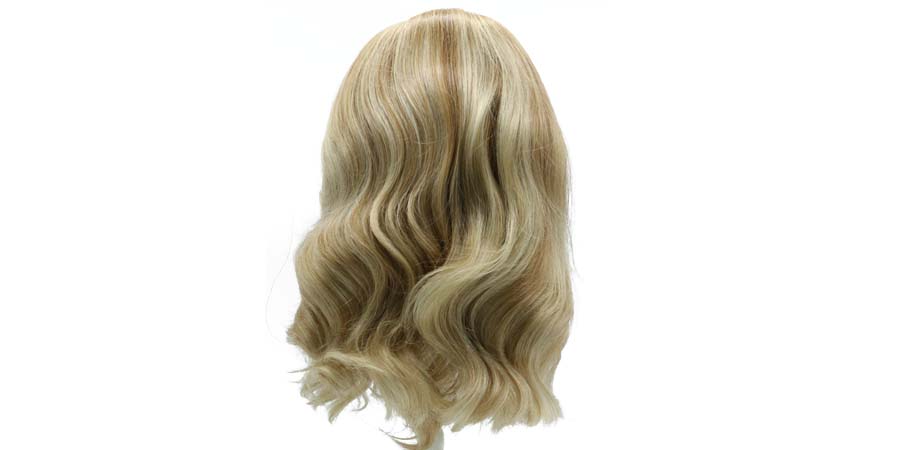The human hair wig industry is experiencing significant growth, driven by shifting consumer preferences, technological advancements, and a growing emphasis on sustainability. Originally designed to address hair loss, wigs have evolved into versatile fashion accessories that allow individuals to experiment with their appearance. As the beauty and fashion landscape continues to diversify, human hair wigs are becoming more popular among consumers of all ages and backgrounds, who seek quality, realism, and the ability to customize their look.
Several key trends are shaping the human hair wig industry. These include the rising demand for wigs that offer a natural appearance, such as Skin Top Wigs and Silk Top Wigs, which are celebrated for their realistic scalp-like features. Additionally, the push towards eco-friendly and sustainable products is influencing manufacturing practices, with brands adopting greener processes and materials. The integration of advanced technologies, like 3D printing and virtual try-on tools, is further revolutionizing the market, making it easier for consumers to find the perfect wig that matches their unique style and needs.
Understanding these trends is crucial for anyone looking to navigate this dynamic and rapidly evolving market. This article delves into the primary categories of human hair wigs, explores the factors driving their increasing demand, and examines the innovative technologies and sustainable practices that are setting the stage for the industry's future growth.

1. Categories of Human Hair Wigs
Human hair wigs are categorized primarily based on their cap structures, which determine the wig’s fit, appearance, and styling versatility. The main types of cap structures include:
-
Lace Front Wigs
-
Lace front wigs feature a sheer lace base along the front hairline, where individual hairs are hand-tied to create a natural-looking hairline. This construction allows for versatile styling, including parting the hair in various directions, and provides a seamless blend with the wearer’s natural hair. Lace front wigs are popular for their realistic appearance and ability to be styled in updos and other hairstyles that expose the hairline.
-
Full Lace Wigs
-
Full lace wigs are made entirely of lace, with individual hairs hand-tied throughout the entire cap. This design offers maximum versatility, allowing the wearer to part the hair anywhere and style it in numerous ways, including updos. Full lace wigs provide a natural look and greater flexibility in styling, but they are typically more expensive due to the labor-intensive production process.
-
Monofilament Wigs
-
Monofilament wigs have a cap made of a thin, breathable material that allows for natural movement of the scalp and hair. Each hair strand is individually tied to the monofilament base, giving the appearance of a natural scalp and allowing for versatile styling. Monofilament wigs are known for their comfort and realistic look, making them a preferred choice for those seeking a natural appearance.
-
Skin Top Wigs
-
Skin top wigs use a layer of polyurethane or similar material at the top, where hairs are implanted to mimic the appearance of a natural scalp. This structure provides a highly realistic look, as the "scalp" is visible through the hair, making it seem as though the hair is growing directly from the scalp. Skin top wigs are ideal for those seeking the most natural look, especially in the parting area.
-
Silk Top Wigs
-
Silk top wigs feature a silk base on the top, with hairs hand-tied underneath the silk layer. This construction creates a "knotless" appearance, as the knots are hidden under the silk, giving the illusion that the hair is growing directly from the scalp. Silk top wigs are considered among the most natural-looking wigs and are highly favored by consumers seeking a flawless and undetectable hairline.
-
360 Lace Wigs
-
360 lace wigs combine elements of lace front and full lace constructions. They have a lace front for a natural hairline and a lace or another breathable material around the perimeter, allowing for updos and styling that expose the sides and back. This type of wig offers a balance between the versatility of full lace wigs and the more affordable lace front wigs.
-
U-Part Wigs
-
U-part wigs feature a U-shaped opening at the top or front of the wig, allowing the wearer to blend their natural hair with the wig seamlessly. This structure is ideal for those who want to maintain a natural hairline while enjoying the convenience of a wig. U-part wigs offer flexibility in styling around the part and can be a cost-effective alternative to full lace wigs.
-
Custom Wigs
-
Custom wigs are tailored to the specific measurements, preferences, and needs of the wearer, allowing for personalized cap constructions. This category can include any of the above cap types, customized to ensure a perfect fit and match to the wearer’s style requirements. Custom wigs are an excellent option for those with unique hair needs or for individuals seeking the highest level of personalization.
2. Drivers of Market Demand Growth
-
The Widespread Issue of Hair Loss
-
Globally, hair loss has become an increasingly common problem due to factors such as genetics, stress, illness, and environmental conditions. Current global health data indicates that over 600 million people are affected by varying degrees of hair loss, with women particularly affected. This has directly driven the demand for human hair wigs. Compared to synthetic wigs, human hair wigs are preferred by those experiencing hair loss due to their natural appearance and realistic texture.
-
The Influence of Fashion and Personalization
-
As societal and cultural diversity grows, more consumers are moving beyond traditional hairstyles, seeking personalized and unique looks. Human hair wigs, with their versatility and adaptability, have become an ideal choice for consumers aiming to create fashionable styles for various occasions. Notably, wigs have become essential for trendsetters and celebrities during events like music festivals and fashion weeks, serving as tools to showcase individuality.
-
Penetration of the Beauty Industry
-
The rapid expansion of the beauty industry has further propelled the demand for human hair wigs. Salons and beauty parlors have begun incorporating wig services into their offerings, providing a one-stop service that includes hair design, coloring, and wig installation. This trend not only enhances the consumer beauty experience but also expands the market share for human hair wigs.
3. The Rise of Personalized Customization
-
Customization Meets Diverse Consumer Needs
-
Traditional wigs are often mass-produced and highly standardized, which makes it difficult to meet the growing demand for personalization. The rise of customized services is changing this scenario. Consumers can now select from different cap structures, lengths, colors, curls, and densities to meet their specific aesthetic and practical needs. This tailored service not only improves the comfort and natural look of wigs but also brings a high level of satisfaction to consumers.
-
Data-Driven Precision Marketing
-
The development of big data and artificial intelligence has made personalized services more precise and efficient. By analyzing consumers’ purchasing history, social media behavior, and personal preferences, brands can offer tailored wig recommendations, increasing the conversion rate. This data-driven marketing approach further accelerates the adoption of personalized customization services.
4. Trends in Sustainability and Environmental Awareness
-
The Use of Sustainable Materials
-
As environmental awareness grows, consumers are increasingly concerned about the ecological footprint of products. Human hair wigs, with their natural material advantages, are gradually replacing synthetic wigs as the mainstream choice for eco-conscious consumers. Some brands are implementing sustainability measures upstream in their supply chains, such as sourcing human hair through ethical channels, reducing chemical usage in production, and adopting recyclable or biodegradable packaging materials.
-
Green Transformation in Production Processes
-
To align with global sustainability trends, human hair wig manufacturers are gradually adopting green production processes. For example, they are replacing traditional chemical dyes with eco-friendly alternatives, reducing environmental pollution, and using low-energy equipment to lower carbon emissions. These measures not only meet environmental standards but also enhance the market competitiveness of the brands.
5. Technological Advancements Driving Industry Innovation
-
The Application of 3D Printing Technology
-
The rise of 3D printing technology has brought revolutionary changes to the manufacturing of human hair wigs. With 3D printing, wig manufacturers can quickly and accurately produce wigs that match consumers’ head shapes and hairstyle requirements. This technology not only improves production efficiency but also significantly enhances the fit and comfort of wigs.
-
Smart Hair Implant Technology
-
Smart hair implant technology is gradually changing how human hair wigs are made. With robotic hair implant technology, manufacturers can more precisely control the density, direction, and angle of hair implantation, producing wigs that are more natural and realistic. This technology also greatly reduces the margin of error in manual operations, improving product consistency and quality.
-
Virtual Try-On Technology
-
With the development of virtual reality (VR) and augmented reality (AR) technologies, consumers can now try on different styles and colors of wigs online using their phones or computers. This technology not only enhances the purchasing experience but also helps brands reduce return rates and inventory pressures.
6. Diverse Market Promotion and Global Expansion
-
The Influence of Social Media
-
The rise of social media platforms has opened up new promotion channels for the human hair wig industry. Through platforms like Instagram, YouTube, and TikTok, brands can directly reach younger generations of consumers, showcasing the diversity and effectiveness of their products. Influencers and beauty vloggers on these platforms significantly boost the exposure and recognition of human hair wigs through their personal experiences and reviews.
-
Global Expansion Through E-Commerce
-
The development of e-commerce has made it easier for consumers to purchase high-quality human hair wigs from around the world. The widespread adoption of cross-border e-commerce platforms allows both domestic and international brands to quickly enter new markets and expand their sales reach. This global expansion trend not only intensifies international competition within the human hair wig industry but also provides consumers with more diverse options.

The human hair wig industry is undergoing unprecedented rapid growth, driven by various factors such as changing market demands, technological innovation, increased environmental awareness, and the expansion of global markets. As more innovative technologies are applied and consumer trends evolve, the human hair wig industry will continue to face new opportunities and challenges, solidifying its position as an integral part of the global beauty and fashion industry.

